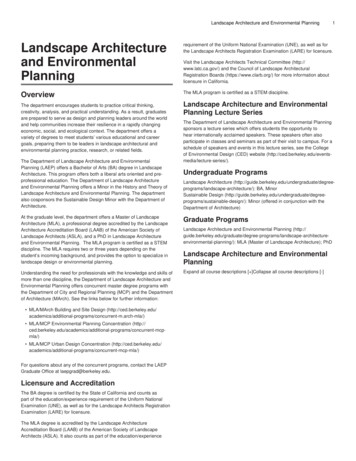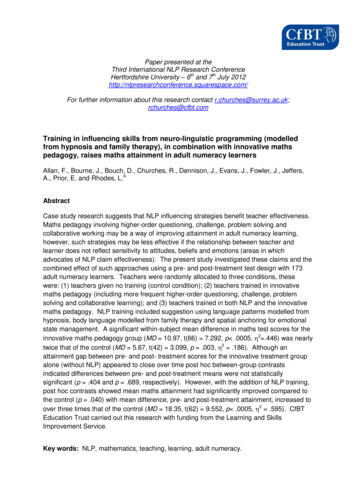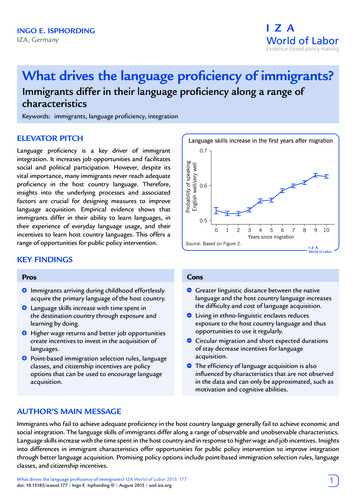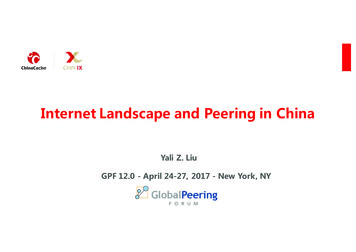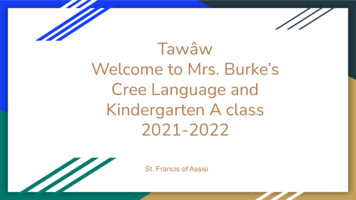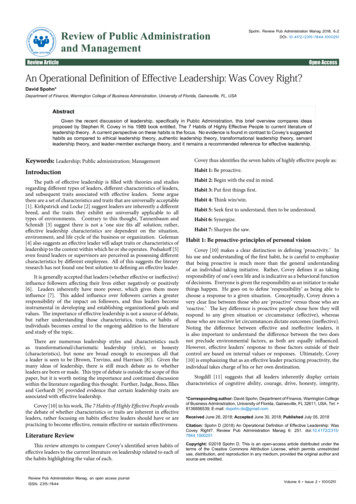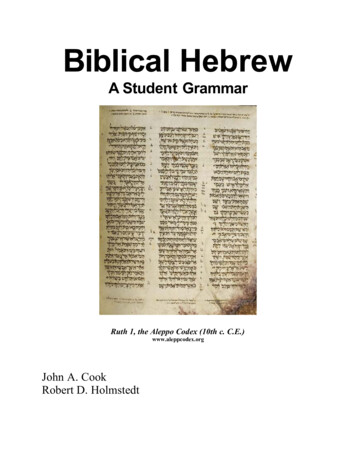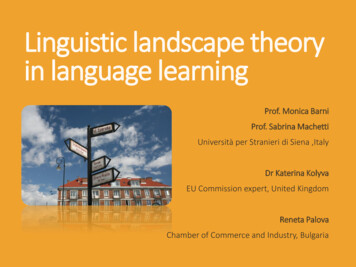
Transcription
Linguistic landscape theoryin language learningProf. Monica BarniProf. Sabrina MachettiUniversità per Stranieri di Siena ,ItalyDr Katerina KolyvaEU Commission expert, United KingdomReneta PalovaChamber of Commerce and Industry, Bulgaria
Linguistic landscape theoryThe concept was first drawn by Landry and Bourhis (1997) in theirseminal work on ethnolinguistic vitality and signage in Canada asVisibility of languages on objects thatmark the public space in a given territory
Linguistic landscape is seen as the scene where the public space issymbolically constructed (Ben-Rafaelet al., 2006; Shohamy &Gorter, 2008)The languages used in public signs indicate what languages arelocally relevant, or give evidence of what languages are becominglocally relevant (Shohamy 2010; Kasanga 2012).Linguistic landscape is becoming a useful method to understandthe evolution of an urban space.Linguistic landscape signs describe the identity of a city and almost‘speaks the language’ of its inhabitants at a moment in time.Collective identity theory, using the notion of space in itsformation, is particularly relevant to the study of linguisticlandscape.
Traditional and essentialist school of thoughtIdentity is static and bounded within specific borders in such a waythat the self is usually identified as never changing
Rational constructivistsIdentity with relation to power, which dictates collective identity;elites promote their interests via the construction of identity.
PostmodernismAnother perspective in LL and identity formationMeaning becomes a fleeting phenomenon that evaporates almostas soon as it occurs in written language or keeps transformingitself into new meanings rather than something fixed
Predominant migrant communities in an urban setting settle inwith their culture, customs and languages and influencesignificantly the Linguistic landscape of that city
“The study of linguistic landscape aims to add another view to ourknowledge about societal multilingualism by focusing on languagechoices, hierarchies of languages, contact-phenomena,regulations, and aspects of literacy’ Gorter (2013: 191)As identity evolves the Linguistic landscape evolves as well
Linguistic landscape can also be applied to the study of competingscripts for a single language
Case study on how the theory of linguisticlandscape can be applied to language awarenessand language eu)How the use of city signs and urban symbols could tell a lot more about the cultureof a place than history ever could and could also be used as a means for languagelearning and language comparisonCity signs provide an easy, visual and clear way to promote language and culturewhile they also provide excellent material for language learning in ‘real life’situations and indeed for comparative linguistic analysis.
The conceptUse of photography of a city’s signs as a means of learning about thecity’s language
The researched places15 cities and towns in Europe – places with different historical andcultural backgrounds and languages that belonged to differentlanguage families from big cities like Izmir in Turkey to very small towns like Birgu inMalta,
The researched places from towns with very long and rich history like Alcalá de Henares inSpain and Gdańsk in Poland to ‘younger’ cities like Dobrich inBulgaria.
The researched places cities where regional and minority languages are an importantmeans of communication, as well as part of their personal, culturaland social identity like Barcelona,
The researched places towns with bilingual communities – Miercurea Cuic in Romania cross-border regions – on the border of Austria and Slovenia
Similarity and difference of Linguisticlandscape in European citiesSimilarities pertaining to a common European cultural heritageSimilarities within geographical or political regions due to history andpolitics (particularly between east and west or north and south)The history and size of every city played a crucial role in its LL profile.
In smaller towns the LL seemed quite static, while in big cities LLseemed much more dynamic.
Similarities were noted between cities that had recently undergonesignificant political change (in Poland and Bulgaria), where theLinguistic landscape pictured the political evolution.
Linguistic landscape and language learningMaterials in 14 languages - short videos and films in the same citiesand towns, online games and printed publications (language learningand storytelling books).Use of “written city language”- street signs, bar, restaurant, shop,banks, post office, graffiti and anything else ‘printed’ as part of a cityPromotion of creativity and respect of cultural and social difference
Specific ‘chapters’ as a guide for the city language:
basic language words and structures great variety of events, products, and originalexpressions based on visualization of culturalspecificities with relation to the linguistic aspectsto demonstrates that the acquaintance with thecity signs vocabulary could be achieved in different waysand that everyone may make their own choice and a fewof them may add their own approach
Language/city guides introduced in an amusing way the alphabet,pronunciation, basic vocabulary necessary forelementary communication that could be seen allover the city.Story and language books
Online language lessons and games
Computer game suitable for younger audiences and was an innovativeway to present the city signs vocabulary to those whoprefer technology to book reading
The use and the potential Tourist and tourist guides Persons in mobility Schools Local authorities
Conclusions There is a clear link between identity theory, linguistic landscapetheory and language learning. Similarity and diversity in identity building is indeed illustrated inlinguistic landscape. City signs provide an easy, visual and clear way to promotelanguage and culture while they also provide excellent material forlanguage learning in ‘real life’ situations and indeed forcomparative linguistic analysis.
Next steps Research with focus on comparing the European experience withthat of other continents to argue (or not) the existence of aEuropean identity and LL trend Development of business and training material for students,tourists and tour guides as well as promotional materials for localauthorities and the tourism and language learning sectors in allEuropean languages
Thank you questions
Tourist and tourist guides Persons in mobility Schools Local authorities The use and the potential There is a clear link between identity theory, linguistic landscape theory and language learning. Similarity an
